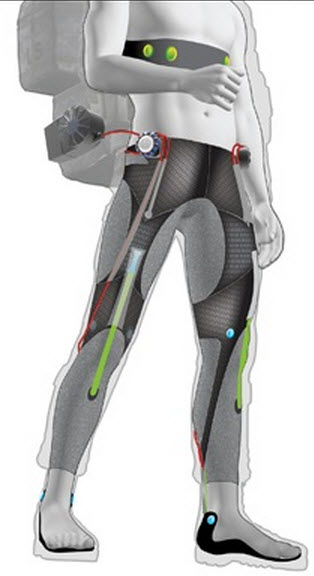A soft ‘wearable robot’ exosuit to increase stamina for soldiers and civilians
September 14, 2014

The Mobility Enhancing Soft Exosuit, a soft wearable robot made from lightweight and flexible materials (credit: Harvard Biodesign Lab)
DARPA has awarded a $2.9 million contract to the Wyss Institute for Biologically Inspired Engineering at Harvard University to further develop the Soft Exosuit, a “wearable robot.”
It will be worn comfortably under clothing to enable soldiers to walk longer distances, reduce fatigue, and minimize risk of injury when carrying heavy loads.
The development is part of DARPA’s Warrior Web program, which seeks to develop technologies to prevent and reduce musculoskeletal injuries for military personnel, but the technologies could also have civilian applications, including first responders, athletes, and the disabled.
The lightweight device is designed to replace power-hungry battery packs and rigid components that can interfere with natural joint movement, as in heavier exoskeleton systems.
“While the idea of a wearable robot is not new, our design approach certainly is,” said Conor Walsh, an Assistant Professor of Mechanical and Biomedical Engineering at the Harvard School of Engineering and Applied Sciences (SEAS) and founder of the Harvard Biodesign Lab.
It is made of soft, functional textiles woven together into a piece of smart clothing that is pulled on like a pair of pants and intended to be worn under a soldier’s regular gear. The suit mimics the action of the leg muscles and tendons when a person walks, and provides small but carefully timed assistance at the joints of the leg without restricting the wearer’s movement.
Soft Robotic Exosuit — Harvard University
The current prototype uses a low-power microprocessor and network of supple strain sensors that act as the “brain” and “nervous system” of the Soft Exosuit, continuously monitoring various data signals, including the suit tension, the position of the wearer (e.g., walking, running, crouched), and more.
The team will also collaborate with clinical partners to develop a medical version of the suit that can help stroke patients, for example.
Collaborators include researchers at Boston University’s College of Health and Rehabilitation Sciences. Harvard postdocs, and Boston-based New Balance.